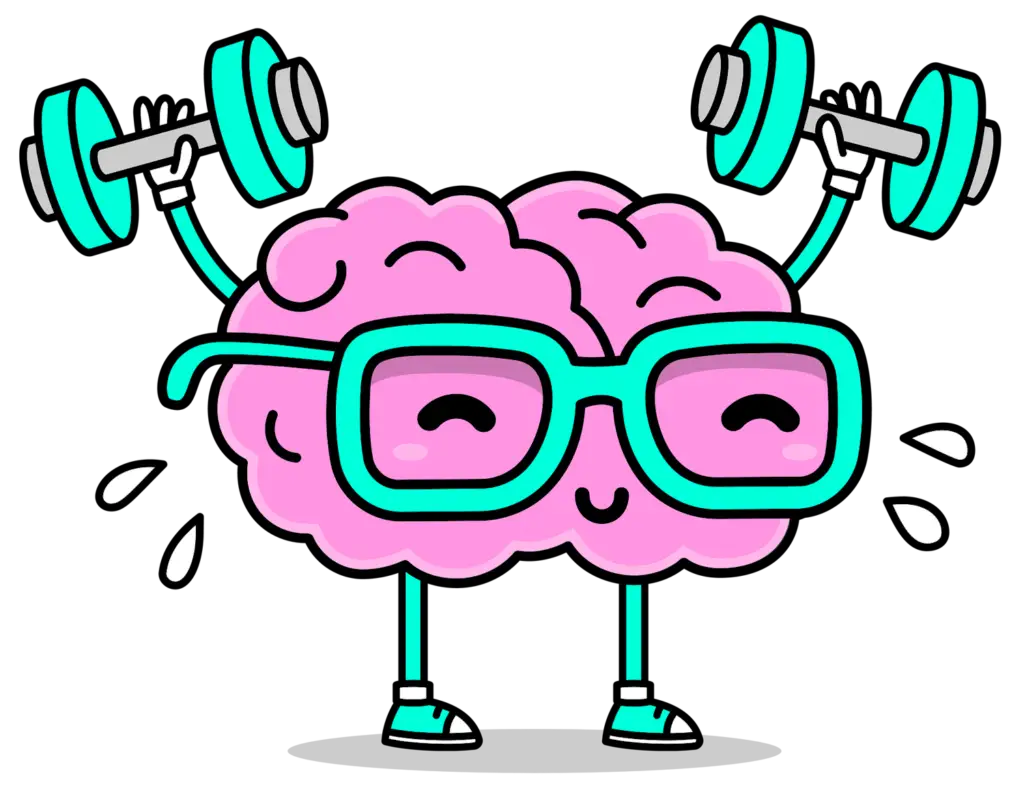Imagine you’re in a new city armed with a map to guide you though the unfamiliar streets. That’s what using mnemonics in language learning can do for your vocabulary journey. It’s like a map in your mind taking you from thought to expression.
In this post, we’ll explore the history, types, and value of mnemonics in language learning. Along the way, we’ll emphasize the importance of fun and stress-free learning methods.
So What are Mnemonics?
Mnemonics are memory aids designed to help you remember information more easily. The main idea is to associate new information with something familiar, making it more memorable.
For example, if you’re learning Spanish, you might remember the word “perro” (dog) by associating it with a dog named “Perry.”
The word “mnemonic” comes from the Greek word “mnemonikos,” which means “of memory” or “relating to memory”. And that word comes from the myth of the Greek goddess of memory, Mnemosyne, the mother of the nine Muses.
Mnemonics Span Centuries Crossing Cultural Boundaries
Ancient Greek philosophers, like Aristotle and Cicero, recognized the power of mnemonics and used them to memorize speeches and important information. Even ancient Indian scholars used mnemonic techniques to preserve vast amounts of knowledge. These included religious texts and poetry, that were passed from genertion to generation through oral tradition.
It’s fascinating to think that mnemonics are not just a modern-day language learning hack. They’ve been employed in various fields, such as mathematics, science, history, and music, throughout history.
And now, we’re rediscovering their value for our own language learning journeys. It’s like finding an old map that’s still relevant today, making our quest for fluency a little less intimidating and a whole lot more enjoyable.
The Value of Mnemonics in Language Learning
Mnemonics can help you develop an instinct for your target language, as they create strong mental associations between new words and familiar concepts. Moreover, mnemonics make language learning more enjoyable by injecting an element of creativity and fun into the process. This relaxed, enjoyable approach can reduce stress and help you stay engaged and motivated.

Different Types of Mnemonics in Language Learning
There are several mnemonic techniques that can be applied to language learning:
Keyword Method: This technique involves associating the sound or meaning of a new word with a familiar word or image. For example, to remember the French word “pomme” (apple), you might imagine a palm tree with apples hanging from it.
The fact that it’s a picture that doesn’t make sense makes it more memorable, so get silly!
Acrostics: Acrostics are phrases or sentences where the first letter of each word represents another word or concept. In language learning, acrostics can help remember word order, conjugation patterns, or lists of vocabulary. For example, the acronym “ROYGBIV” can help you remember the colors of the rainbow in English: red, orange, yellow, green, blue, indigo, and violet.
Memory Palace: Also known as the Method of Loci, this technique involves visualizing a familiar location and placing new information within that mental space. For language learning, you might imagine a room in your house where each piece of furniture represents a new vocabulary word.
These are just a few examples, but there are countless other mnemonic techniques that can be tailored to individual learners’ needs and preferences.
Combining Mnemonics with Other Language Learning Methods
Incorporating mnemonics into a well-rounded language learning strategy can maximize their effectiveness. Complementary methods might include listening to native speakers, engaging in conversation, and playing vocabulary games.
By combining these approaches, you can develop a more complete understanding of your target language. Create a personalized language learning plan that incorporates mnemonics alongside other techniques to optimize your progress.
Overcoming Psychological Barriers with Mnemonics
Using mnemonics can also help learners overcome psychological barriers such as fear, lack of confidence, and self-doubt. By simplifying the process of learning new vocabulary, mnemonics can boost confidence and make language learning feel more accessible. For example, a student who struggled with learning vocabulary might feel a sense of accomplishment after successfully using mnemonics to remember new words.
Tips for Creating Effective Mnemonics
Here are sometips to help you create memorable and effective mnemonics:
Visualization: Use vivid and detailed mental images to strengthen the associations between new information and familiar concepts.
Humor: Funny mnemonics are often more memorable because they engage our emotions and make learning more enjoyable.
Personal connections: Incorporate personal experiences, memories, or emotions into your mnemonics to make them more meaningful and memorable.
Repetition: Practice and review your mnemonics regularly to reinforce the connections and enhance recall.
A Few Examples
Spanish: To remember the word “felicidad” (happiness), imagine a cat (similar to “feline”) sitting on a pillow, looking content and happy. This image can help you associate “felicidad” with the feeling of happiness.

French: To learn the word “bibliothèque” (library), think of a “baby elephant” (similar in sound) reading a book. This whimsical image can help you associate “bibliothèque” with a place where books are found.
German: For the word “Schmetterling” (butterfly), visualize a “smattering” of butter on a slice of bread taking flight like a butterfly. This association can help you remember that “Schmetterling” means butterfly.
Italian: To memorize the word “spiaggia” (beach), imagine a “spaghetti” beach with strands of pasta instead of sand. This quirky image can help you associate “spiaggia” with the idea of a beach.
Idiomatic expressions: To remember the English idiom “to let the cat out of the bag” (meaning to reveal a secret) visualize a literal cat escaping from a bag and spreading the secret around.
Challenges of Using Mnemonics
Not all words or concepts lend themselves easily to mnemonic techniques. In such cases, consider the following alternative approaches:
Break it down: Divide the word into smaller parts or syllables and create mnemonics for each part. Then, combine the smaller mnemonics to remember the entire word. This can make complex or lengthy words more manageable and memorable.
Use multiple techniques: If one mnemonic technique isn’t working, try another. For example, if the Keyword Method doesn’t seem effective for a particular word, you might try an acrostic or even create a short story or rhyme that uses the word.
Contextual learning: Learn the word in context by studying sentences or phrases that include it. By understanding how the word is used in real-life situations, you can create stronger mental associations that help you remember it more easily.
Make it personal: Relate the word to something in your own life or experiences. This personal connection can help make the word easier to remember, even if it doesn’t lend itself to a traditional mnemonic technique.
Repetition and active learning: Sometimes, the best way to learn a challenging word is through repetition and active engagement with the language. Practice writing, speaking, listening, and reading the word to boost its meaning and pronunciation.
How hard is it?
At this point you might be wondering if it’s hard coming up with new, imaginative situations for every word. And I agree, at first, creating mnemonics might seem time-consuming.
But with practice, it becomes easier and more effective. As you become more familiar with the techniques and find what works for you, you’ll see that creating mnemonics takes less time and effort.
Also, despite the initial effort, mnemonics can save you time in the long run. By helping you remember words more effectively, they reduce the need for frequent repetition and review. If you invest a little extra time upfront, you can spend less time on memorization later.

Here are some ways to ease the burden:
Collaborate: You can work with other students of your target language to create mnemonics, sharing ideas and learning from one another. This team approach can save time and inspire creativity, making the process of creating mnemonics more fun and efficient.
Pre-existing resources: There are numerous resources available online, such as websites, forums, and language learning apps, where learners can find mnemonics created by other language learners. Memrise, and Fluent Forever are two of them. Using pre-existing mnemonics can save time and provide inspiration for creating your own.
Emphasize quality over quantity: Focus on creating mnemonics for words or concepts you find particularly challenging, rather than trying to create one for every new word you encounter. This targeted approach will ensure you’re investing your time and imagination wisely.
Mnemonics are a powerful tool
By including mnemonics into your learning routine, you can develop an instinct for your target language, reduce stress, and overcome psychological barriers. So, why not give mnemonics a try? And don’t forget to explore other fun language learning methods, like the vocabulary game on our website.
Embrace the power of mnemonics and unlock new levels of success on your language learning journey. Happy learning!




